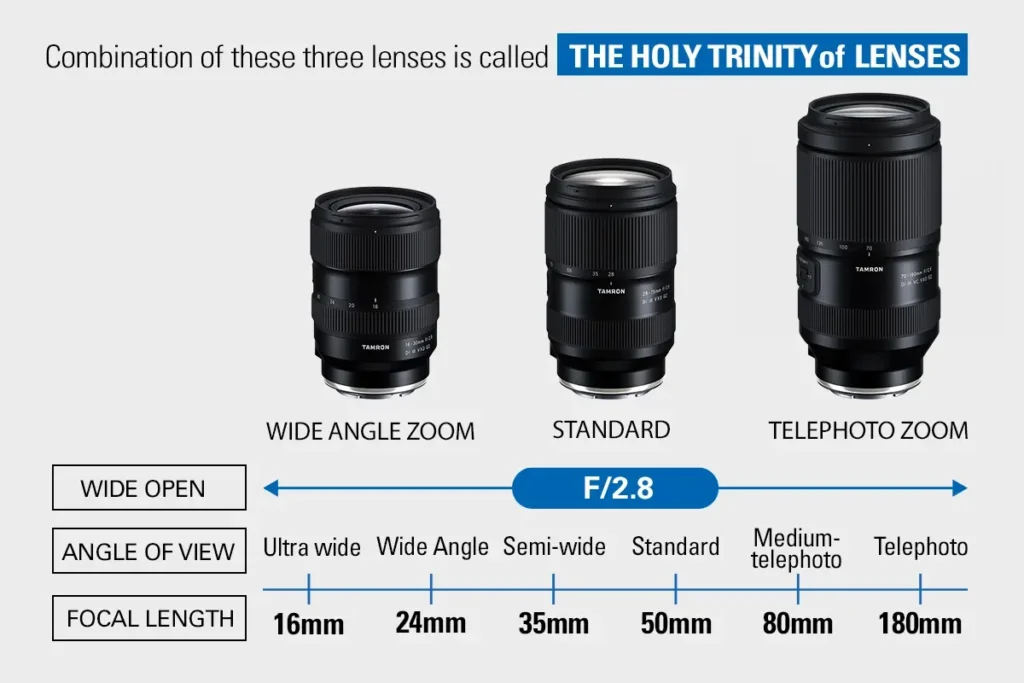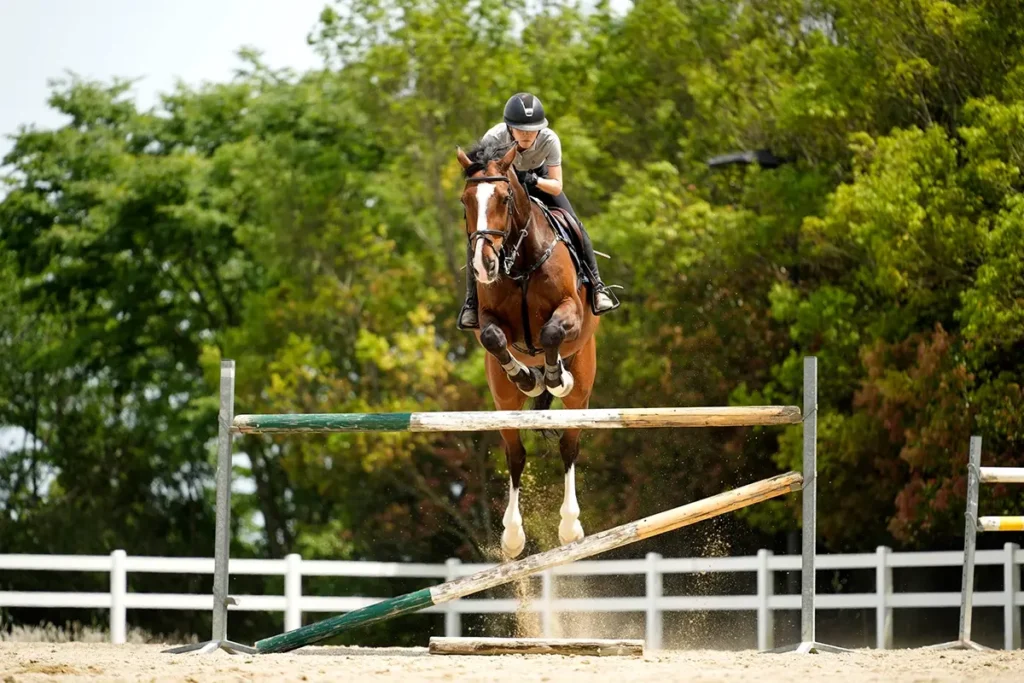Many photographers have heard the terms “trinity lenses,” “holy trinity of lenses,” or “the lens trinity,” but may be unsure what they really mean. This guide explains the appeal, characteristics, and recommended usage of trinity lenses, plus how Tamron’s fast F2.8 G2 series offers a lighter, more affordable alternative for Sony and Nikon shooters.
What You’ll Learn In This Article:
- What trinity lenses are and why they’re called the “holy trinity of lenses”
- The difference between F2.8 trinity lenses and F4 trinity lenses
- Key features: brightness, resolving power, and versatility
- Recommended shooting scenarios for trinity lenses (landscape, sports, events, low light)
- Tamron’s trinity lenses for Sony and Nikon mirrorless cameras
What Are Trinity Lenses?

“Trinity lenses” refers to three fast zoom lenses with a constant F2.8 maximum aperture—a wide-angle zoom, standard zoom, and telephoto zoom. Collectively, these cover nearly all focal lengths a photographer needs while maintaining consistent brightness and image quality.
This combination allows photographers to capture everything from sweeping landscapes to action-packed sports without sacrificing low-light performance or bokeh.
What is an F4 Trinity Lens?
Alongside the F2.8 versions, some manufacturers also produce F4 trinity lenses. These offer similar focal length coverage but with a smaller maximum aperture. The trade-off:
- Less light intake compared to F2.8 versions discussed in this article
- Lighter weight and smaller size
Three Characteristics of Holy Trinity Lenses
(1) Brightness with a Constant F2.8 Maximum Aperture
One of the most important features of trinity lenses is their F-number or aperture. Trinity lenses have the ability to maintain a constant F2.8 maximum aperture across the zoom range. A wide aperture like F2.8 allows more light to reach the camera sensor, resulting in:
- Faster shutter speeds to freeze motion
- Lower ISO settings for cleaner, noise-free images
- Beautiful shallow depth of field for subject separation and smooth bokeh
Because these lenses are considered “bright,” they perform exceptionally well in low-light situations such as indoor photography, concerts, weddings, or capturing moving subjects at dusk. For photographers who shoot in challenging lighting conditions, the constant F2.8 aperture is a game-changer.
Pro Tip: Shooting indoors at a wedding reception? A trinity lens at F2.8 lets you capture sharp, vibrant images without needing flash.
(2) High Resolving Performance for Image Quality
Trinity lenses are engineered with advanced optics, specialized glass elements, and high-grade coatings, ensuring excellent image sharpness, contrast, and color accuracy. This level of resolving power means photographers can:
- Capture fine details in landscapes or architecture
- Render smooth tonal transitions in portraits
- Produce images with vibrant colors and rich depth
Many professionals choose the holy trinity of lenses because they rival prime lenses in rendering performance while offering the flexibility of zoom. Whether you’re shooting commercially or just want professional-level clarity, trinity lenses consistently deliver high image quality.
Did You Know? Many photographers rely on the holy trinity of lenses because they rival prime lenses in quality—while offering the flexibility of zoom.
(3) Versatility Across Shooting Scenarios
Perhaps the greatest strength of the lens trinity is its versatility. Since all three lenses share the same F2.8 maximum aperture, photographers can switch between wide, standard, and telephoto without worrying about exposure changes or inconsistent bokeh.
This consistency allows for smooth shooting across different scenarios, such as:
- Sports and action photography
- Wedding and event coverage
- Travel and documentary work
From capturing a dramatic wide-angle landscape to zooming in on a fast-moving subject, trinity lenses adapt seamlessly, making them the go-to kit for serious enthusiasts and professionals alike.
Pro Tip: With the trinity set, you can confidently cover a full wedding day—from wide group shots to telephoto candids—without missing a beat.
Recommended Shooting Scenarios for Trinity Lenses
One of the biggest advantages of the holy trinity of lenses is their ability to cover virtually every shooting scenario a photographer might encounter. With a wide-angle, standard zoom, and telephoto lens—each with a constant F2.8 aperture—you can shoot with confidence in almost any environment. Below are some of the most common ways photographers put trinity lenses to work.
Landscape Photography

Wide-angle trinity lenses are perfect for capturing expansive landscapes with sharpness from edge to edge. Their ability to gather more light allows you to shoot:
- Dramatic mountain ranges or cityscapes in golden hour light
- Starry skies and nightscapes where faint light sources must be rendered clearly
- Backlit scenes at sunrise or sunset with reduced ghosting and flare
The holy trinity of lenses ensures that details—like textures in rocks, leaves, or architecture—are preserved with high clarity while still allowing you to create expressive compositions with foreground depth and wide perspective.
Pro Tip: Pair a Tamron 16-30mm F2.8 with a tripod for astrophotography—the wide angle and F2.8 aperture are perfect for star trails and the Milky Way.
Portraits and Indoor Photography

Indoor environments often have low and inconsistent lighting, making fast lenses essential. A standard zoom from the trinity makes it easier to:
- Photograph family gatherings, events, or ceremonies without flash
- Maintain creamy background bokeh for subject isolation
- Use lower ISO settings for cleaner images
For wedding or event photographers, this consistency across the lens trinity ensures you can move from dimly lit receptions to brighter venues without compromising exposure or image quality.
Moving Subjects

From pets racing across the yard to children playing indoors, trinity lenses excel at freezing fast-moving subjects. Thanks to the constant F2.8 aperture and advanced autofocus systems, you can:
- Capture decisive action moments with sharpness
- Maintain a faster shutter speed to reduce blur from handholding
- Work in tricky lighting such as shady areas or backlit conditions
This flexibility makes the holy trinity of lenses a staple for photographers who document life’s candid moments, whether indoors or outdoors.
Sports & Action Photography

Sports photography demands speed, reach, and adaptability, all of which the trinity lenses deliver. With a telephoto zoom, you can:
- Zoom in close on the action with sharp detail
- Capture wide-angle environmental shots for context
- Handle both outdoor daylight sports and dimly lit gymnasiums
Because Tamron’s G2 lenses also incorporate the fast VXD autofocus motor as well as Vibration Compensation (VC) in some, they help photographers lock focus quickly and reduce blur even when handholding at long focal lengths. This makes the holy trinity of lenses invaluable for everything from high school sports to professional events.
Pro Tip: Tamron’s 70-180mm F2.8 with VC (Vibration Compensation) is a favorite for indoor sports, letting you shoot handheld with confidence.
Important Factors When Choosing Trinity Lenses
Even when talking about the holy trinity of lenses, it’s important to recognize that not all models are created equal. Each lens has its own strengths, and choosing the right set of trinity lenses depends on your shooting style, subject matter, and practical needs. Here are the most important factors to consider:
Resolving Performance and Image Quality

For many photographers, the primary reason to invest in trinity lenses is to maximize image quality. Most trinity lenses offer excellent resolving power, high contrast, and strong color reproduction, but subtle differences can appear between brands and models.
- Some lenses produce more vibrant colors or smoother gradation.
- Others excel at rendering a three-dimensional sense of depth or producing especially creamy bokeh.
- Lens coatings may also play a role, helping reduce ghosting and flare in backlit conditions.
Pro Tip: Before buying, compare MTF charts, sample photos, and real-world reviews to confirm whether a lens can deliver the image quality and style you want.
Weight and Compactness

The holy trinity of lenses are versatile, but they can also be large and heavy due to their constant F2.8 aperture and advanced optics. This makes weight an important factor for many photographers—especially for travel, wedding, or event photography, where gear is carried for hours.
However, Tamron’s trinity lenses provide pro-level optical performance as well as lightweight, compact handling. Their smaller form factor and shared 67mm filter size also add convenience for photographers who value portability.
Pro Tip: A lighter trinity lens kit means you’ll be more likely to carry all three lenses on long shoots or trips—ensuring you never miss a shot.
MOD (Minimum Object Distance)

MOD is the minimum distance between your subject and the image sensor at which the lens can achieve focus. Lenses with a shorter MOD allow photographers to get closer to subjects, opening creative possibilities:
- Semi-macro style images with dramatic detail
- Unique perspectives where the subject fills the frame
- Intimate portraits with close-up background separation
When combined with the F2.8 aperture of the trinity lenses, a shorter MOD enables you to create expressive photos with sharp subjects and smooth, defocused backgrounds.
Auto Focus Speed and Accuracy

Since trinity lenses are often used in dynamic scenarios—such as sports, weddings, and live events—fast and accurate autofocus is crucial. Look for:
- Linear or VXD (Voice-coil Extreme-torque Drive) motors for quick, quiet focusing
- Strong subject tracking for moving people, animals, or athletes
- Smooth focusing transitions for hybrid photo/video shooters
Tamron’s trinity lenses feature high-performance AF systems that ensure sharpness even in low light or when tracking unpredictable movement.
Vibration Compensation (VC) or Image Stabilization

When shooting handheld—especially at longer focal lengths—camera shake can quickly soften an image. Many modern holy trinity of lenses include stabilization systems, like Tamron’s VC (Vibration Compensation), to help:
- Capture sharper handheld shots in low light
- Stabilize telephoto shooting for action and sports
- Improve video stability for content creators
Pro Tip: Even if your camera body has in-body stabilization, pairing it with VC in a Tamron trinity lens gives you even more stability when shooting at slower shutter speeds.
<H2>Tamron’s Holy Trinity Lenses for Sony and Nikon
Tamron delivers a lightweight, affordable, and professional-grade F2.8 G2 trinity for full-frame Sony E-mount and Nikon Z-mount cameras:
- Wide-angle: 16-30mm F/2.8 Di III VXD G2 (Models A064S and A064Z)
- Standard: 28-75mm F/2.8 Di III VXD G2 (Models A063S and A064Z)
- Telephoto: 70-180mm F/2.8 Di III VC VXD G2 (Models A065S and A065Z)
Key Features:
- Compact, lightweight design
- Shared 67mm filter size
- Fast, quiet VXD autofocus motor
- Tamron Lens Utility™ compatibility >>
- Moisture-resistant construction
Did you know? One Sony or Nikon OEM trinity lens can cost as much as all three Tamron G2 trinity lenses combined—making Tamron a smart choice for photographers of any level.
Conclusion: Why Invest in Trinity Lenses?
The holy trinity of lenses offers unmatched versatility, professional image quality, and low-light performance across focal lengths. When you choose Tamron’s G2 Nikon trinity lenses or the Sony holy trinity lenses, you have built the foundation of any serious photographer’s kit.
Tamron’s G2 lineup provides the perfect balance of performance, portability, and value, providing you with a professional-grade Nikon lens trinity or Sony set without compromise.
Learn more about Tamron trinity lenses at an authorized Tamron dealer near you or shop now at the official TAMRON Store.
